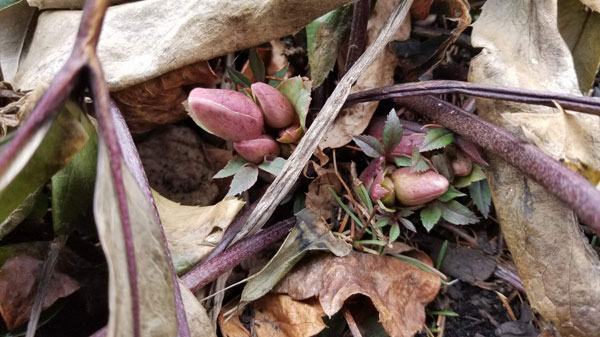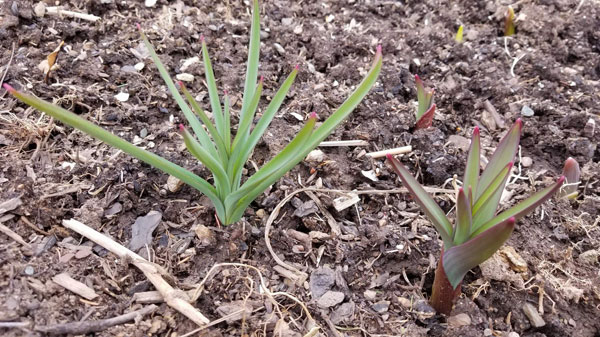 Spring is moving along. Not at a sprint, not even a jog… more like those 50+ people you see walking briskly along the road, arms swinging like a windmill. Purposeful and steady, just not as fast as we’d wish spring to develop. The signs are numerous outdoors, and I’ll get to those in a minute, but it’s fun to see the parallels indoors too- the heat pump not needing to pump anymore, the windows occasionally being opened, and eventually windows even open at night. Outdoors the plant world is really coming alive. Not in a colourful way yet, save for a few spring bulbs like crocus and snowdrop. Several shrubs have colourful flower buds though, and the earliest of those will likely be in bloom by the time you read this, February daphne. This was mine today, its lilac buds plump and fully coloured. Those pointed buds will soon open to tiny very fragrant flowers that brave the cold nights of late April and early May. The few insects that appear on warm sunny afternoons now must appreciate this rather rare source of nectar. That attraction certainly works for the daphnes, as they are covered in red berries later in the summer. You may be aware that certain perennials are considered short-term, not likely to last more than two or three seasons in one spot. Hollyhock, columbine, lupine, and Delphinium come to mind. Seldom though do you hear of a shrub being classified that way. The distinction does however apply to daphne. Customers frequently point out 3 or 4 year old daphnes that seemed to die suddenly with no apparent cause. They are also known to not transplant very well once established. Fortunately there are often lots of little seedlings under or near the mature shrubs, which transplant fine and grow into a bushy compact shrub in two or three years.
Spring is moving along. Not at a sprint, not even a jog… more like those 50+ people you see walking briskly along the road, arms swinging like a windmill. Purposeful and steady, just not as fast as we’d wish spring to develop. The signs are numerous outdoors, and I’ll get to those in a minute, but it’s fun to see the parallels indoors too- the heat pump not needing to pump anymore, the windows occasionally being opened, and eventually windows even open at night. Outdoors the plant world is really coming alive. Not in a colourful way yet, save for a few spring bulbs like crocus and snowdrop. Several shrubs have colourful flower buds though, and the earliest of those will likely be in bloom by the time you read this, February daphne. This was mine today, its lilac buds plump and fully coloured. Those pointed buds will soon open to tiny very fragrant flowers that brave the cold nights of late April and early May. The few insects that appear on warm sunny afternoons now must appreciate this rather rare source of nectar. That attraction certainly works for the daphnes, as they are covered in red berries later in the summer. You may be aware that certain perennials are considered short-term, not likely to last more than two or three seasons in one spot. Hollyhock, columbine, lupine, and Delphinium come to mind. Seldom though do you hear of a shrub being classified that way. The distinction does however apply to daphne. Customers frequently point out 3 or 4 year old daphnes that seemed to die suddenly with no apparent cause. They are also known to not transplant very well once established. Fortunately there are often lots of little seedlings under or near the mature shrubs, which transplant fine and grow into a bushy compact shrub in two or three years.
 My morning stroll revealed another set of flower buds looking plump and full of promise. Our one Hellebore (Lenten Rose), now well-established and large after three years in place, had many clusters of fat flower buds pushing up through last year’s mat of dead leaves. Everything about these uncommon early bloomers is unique and attractive. Their leaves are dark green, shiny and leathery, with purplish stems, the flowers are cream with pinkish overtones, and soft yellow reproductive parts in the center. Like many early spring bloomers, they protect themselves from ice and cold by drooping and closing at night, only bending upwards in the safety of warm sunshine, when the pollinators are most likely to find them. Their quiet elegant display lasts for all of May, at least.
My morning stroll revealed another set of flower buds looking plump and full of promise. Our one Hellebore (Lenten Rose), now well-established and large after three years in place, had many clusters of fat flower buds pushing up through last year’s mat of dead leaves. Everything about these uncommon early bloomers is unique and attractive. Their leaves are dark green, shiny and leathery, with purplish stems, the flowers are cream with pinkish overtones, and soft yellow reproductive parts in the center. Like many early spring bloomers, they protect themselves from ice and cold by drooping and closing at night, only bending upwards in the safety of warm sunshine, when the pollinators are most likely to find them. Their quiet elegant display lasts for all of May, at least.
 Last year I planted many groups of monkshood, both the two-toned bloomer bicolour monkshood, and the tall, late-summer bloomer, autumn monkshood. Sure enough, 2”spikes of deeply lobed miniature leaves are now popping up in groups of 3 to 7 everywhere. I Iove the feeling that I have established something very close to permanent in the many beds on the property. Never again should I have to buy any more bicolour or autumn monkshoods. They are long-lived perennials unlike delphiniums or black-eyed Susans, so the clumps will thicken each year, and provide unlimited divisions for starting future beds.
Last year I planted many groups of monkshood, both the two-toned bloomer bicolour monkshood, and the tall, late-summer bloomer, autumn monkshood. Sure enough, 2”spikes of deeply lobed miniature leaves are now popping up in groups of 3 to 7 everywhere. I Iove the feeling that I have established something very close to permanent in the many beds on the property. Never again should I have to buy any more bicolour or autumn monkshoods. They are long-lived perennials unlike delphiniums or black-eyed Susans, so the clumps will thicken each year, and provide unlimited divisions for starting future beds.
 The fourth shot in this collage is of a well-advanced bulb plant, allium, looking very much like its onion-family cousin, garlic. As bulb flowers go, alliums can be very long-term, even slowly multiplying, provided they get plenty of sunshine. I can’t say the same for tulips, which seem to rather quickly peter-out after their first fantastic year. The alliums form a rosette of leaves for a month or so, then send up a tall single stem with a gorgeous lilac-purple flower ball at the top, 3-4” in diameter. There is only one flower per bulb, so a fair number should be planted in a cluster to make a visual impact (6-12 or more, planted 6 or 8” apart). Like most bulbs, after the dramatic spring display, the tops aren’t too long withering away, leaving the plants invisible at the surface for the latter half of the season. That, I find, makes managing bulbs a bit challenging. I am quick to forget where big patches of daffodils or tulips are, and dig them up while cultivating the garden, dividing perennials, or transplanting shrubs. The result next spring can be bulbs popping up through new drifts of perennials, or right underneath the new rhododendron. A few suggestions to prevent this… take pictures of the bed when the bulbs are in bloom, put small metal garden tags in the bulb clusters to mark them, and plant bulbs in low-traffic areas out of the way of other garden operations, like near walls or at the bases of large shrubs.
The fourth shot in this collage is of a well-advanced bulb plant, allium, looking very much like its onion-family cousin, garlic. As bulb flowers go, alliums can be very long-term, even slowly multiplying, provided they get plenty of sunshine. I can’t say the same for tulips, which seem to rather quickly peter-out after their first fantastic year. The alliums form a rosette of leaves for a month or so, then send up a tall single stem with a gorgeous lilac-purple flower ball at the top, 3-4” in diameter. There is only one flower per bulb, so a fair number should be planted in a cluster to make a visual impact (6-12 or more, planted 6 or 8” apart). Like most bulbs, after the dramatic spring display, the tops aren’t too long withering away, leaving the plants invisible at the surface for the latter half of the season. That, I find, makes managing bulbs a bit challenging. I am quick to forget where big patches of daffodils or tulips are, and dig them up while cultivating the garden, dividing perennials, or transplanting shrubs. The result next spring can be bulbs popping up through new drifts of perennials, or right underneath the new rhododendron. A few suggestions to prevent this… take pictures of the bed when the bulbs are in bloom, put small metal garden tags in the bulb clusters to mark them, and plant bulbs in low-traffic areas out of the way of other garden operations, like near walls or at the bases of large shrubs.
I am happy to report too about this rather random group of four plants I encountered on my walk
this morning that they are each highly deer-resistant, making great additions to your deer-proof garden!
